Solar eclipse of August 2, 2027
A total solar eclipse will occur at the Moon's descending node of orbit on Monday, August 2, 2027,[1] with a magnitude of 1.079. A solar eclipse occurs when the Moon passes between Earth and the Sun, thereby totally or partly obscuring the image of the Sun for a viewer on Earth. A total solar eclipse occurs when the Moon's apparent diameter is larger than the Sun's, blocking all direct sunlight, turning day into darkness. Totality occurs in a narrow path across Earth's surface, with the partial solar eclipse visible over a surrounding region thousands of kilometres wide. Occurring only about 2.5 hours before perigee (on August 2, 2027, at 7:25 UTC), the Moon's apparent diameter will be larger.[2]
Path
Totality will commence over the eastern Atlantic Ocean and travel across the Strait of Gibraltar between Spain and Morocco, and continue across parts of North Africa and the Middle East. Major cities and locations under the path of totality will include:[3]
- Cadiz and Malaga, in southern Spain
- Gibraltar
- Tangier, Morocco
- Oran, Algeria
- Sfax, Tunisia
- Benghazi, Libya
- Luxor in central Egypt
- Jeddah and Mecca in southwest Saudi Arabia
- Sana'a in western Yemen
- The tip of the Horn of Africa in extreme northeast Somalia
- Islands in the British Indian Ocean Territory
The maximum duration of totality will be observed in Egypt, approximately 37 miles (60 km) southeast of Luxor, and will last 6 minutes and 22 seconds.[4]
A partial solar eclipse will be visible from the extreme east tip of Maine, United States, far eastern Quebec and the Atlantic Provinces in Canada, southern Greenland, Iceland, Ireland, Great Britain, nearly the entirety of the European continent, all but the southern quarter of Africa, the Middle East, and from South and Southeast Asia.[3]
It will be the first of three total solar eclipses that are observable in Tunisia in the 21st century, passing over the central part of the country.[5] It will be the second total eclipse in Spain within a year, after August 2026. An annular eclipse will appear in Spain in January 2028. A national eclipse committee has been established to coordinate eclipse-related activities.[6]
Duration
This is the second longest total solar eclipse in the 21st century, the longest being the eclipse prior to this one in Solar Saros 136, that of July 22, 2009. The 2009 eclipse maximum duration of 6 minutes and 39.5 seconds occurred on the Pacific Ocean, and the longest duration on land was on remote, uninhabited North Iwo Jima.[7] The maximum duration of this eclipse is 6 minutes and 23.2 seconds, occurring in the northeastern part of Egypt's New Valley Governorate. The location of the greatest eclipse is about 250 kilometres (160 mi) southeast in Red Sea Governorate, with a slightly shorter duration. This is the longest total solar eclipse on easily accessible land in the 21st century; a longer one will not occur until June 3, 2114.[8]
Images
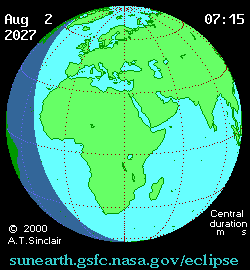
Animated path
Details of totality in some places or cities
| Country or Territory | Place or City | Start of | Start of total eclipse (Local Time) | End of total eclipse (Local Time) | Duration of total eclipse | End of partial eclipse (Local Time) | Magnitude |
|---|---|---|---|---|---|---|---|
 Morocco Morocco | Tangier | 08:40:33 | 09:44:38 | 09:49:29 | 4 min 50s | 11:00:20 | 1,072 |
 Spain Spain | Tarifa | 09:40:50 | 10:45:05 | 10:49:44 | 4 min 39 s | 12:00:42 | 1,072 |
 Morocco Morocco | Tétouan | 08:40:47 | 09:45:10 | 09:50:01 | 4 min 51s | 11:01:10 | 1,072 |
 Spain Spain | Cadiz | 09:40:42 | 10:45:18 | 10:48:21 | 3 min 03 s | 11:59:35 | 1,072 |
 Spain Spain | Ceuta | 09:40:58 | 10:45:19 | 10:50:07 | 4 min 48 s | 12:01:11 | 1,072 |
 Spain Spain | Algeciras | 09:41:01 | 10:45:25 | 10:49:54 | 4 min 29 s | 12:00:59 | 1,072 |
 Gibraltar Gibraltar | Gibraltar | 09:41:04 | 10:45:30 | 10:50:01 | 4 min 31 s | 12:01:07 | 1,072 |
 Spain Spain | Marbella | 09:41:37 | 10:46:46 | 10:50:05 | 3 min 18 s | 12:01:50 | 1,072 |
 Spain Spain | Benalmádena | 09:41:55 | 10:47:26 | 10:50:19 | 2 min 53 s | 12:02:26 | 1,072 |
 Spain Spain | Malaga | 09:42:04 | 10:48:07 | 10:50:00 | 1 min 53 s | 12:02:36 | 1,072 |
 Spain Spain | Melilla | 09:42:22 | 10:48:12 | 10:52:44 | 4 min 33 s | 12:05:20 | 1,073 |
 Morocco Morocco | Nador | 08:42:22 | 09:48:13 | 09:52:44 | 4 min 31 s | 11:05:21 | 1,073 |
 Spain Spain | Motril | 09:42:43 | 10:49:18 | 10:50:59 | 1 min 41 s | 12:04:04 | 1,073 |
 Morocco Morocco | Oujda | 08:42:56 | 09:50:55 | 09:52:27 | 1 min 32 s | 11:07:16 | 1,073 |
 Algeria Algeria | Tlemcen | 08:43:30 | 09:50:56 | 09:54:07 | 3 min 11 s | 11:08:19 | 1,073 |
 Algeria Algeria | Oran | 08:44:26 | 09:51:03 | 09:56:11 | 5 min 08 s | 11:09:22 | 1,073 |
 Algeria Algeria | Bou Saâda | 08:48:46 | 09:57:55 | 10:03:12 | 5 min 17 s | 11:18:30 | 1,075 |
 Algeria Algeria | Blida | 08:47:55 | 09:57:10 | 10:00:01 | 2 min 51 s | 11:15:21 | 1,074 |
 Algeria Algeria | Batna | 08:51:01 | 10:01:03 | 10:06:20 | 5 min 17 s | 11:22:09 | 1,075 |
 Tunisia Tunisia | Sfax | 08:56:23 | 10:08:46 | 10:14:26 | 5 min 40 s | 11:31:45 | 1,076 |
 Tunisia Tunisia | Kairouan | 08:55:43 | 10:08:49 | 10:11:33 | 2 min 44 s | 11:29:36 | 1,076 |
 Libya Libya | Northeast of Tripoli | 09:59:46 | 11:16:28 | 11:17:23 | 55 s | 12:38:32 | 1,077 |
 Libya Libya | Al-Khums | 10:01:17 | 11:18:40 | 11:19:23 | 43 s | 12:40:53 | 1,077 |
 Libya Libya | Benghasi | 10:10:41 | 11:27:51 | 11:34:00 | 6 m 09 s | 12:53:15 | 1,078 |
 Egypt Egypt | Siwa Oasis | 11:22:11 | 12:42:33 | 12:48:03 | 5 min 30 s | 14:08:04 | 1,079 |
 Egypt Egypt | Asyut | 11:35:29 | 12:56:52 | 13:02:59 | 6 min 07 s | 14:21:28 | 1,079 |
 Egypt Egypt | Sohag | 11:37:13 | 12:58:44 | 13:05:07 | 6 min 22 s | 14:23:25 | 1,079 |
 Egypt Egypt | Qena | 11:39:51 | 13:01:33 | 13:07:45 | 6 min 12 s | 14:25:48 | 1,079 |
 Egypt Egypt | Luxor | 11:40:12 | 13:02:02 | 13:08:23 | 6 min 21 s | 14:26:30 | 1,079 |
 Saudi Arabia Saudi Arabia | Jeddah | 12:00:22 | 13:22:16 | 13:28:16 | 6 min 00 s | 14:43:44 | 1,079 |
 Saudi Arabia Saudi Arabia | Mecca | 12:01:56 | 13:24:02 | 13:29:09 | 5 min 07 s | 14:44:41 | 1,079 |
 Saudi Arabia Saudi Arabia | Taif | 12:03:32 | 13:26:02 | 13:29:55 | 3 min 53 s | 14:45:43 | 1,079 |
 Saudi Arabia Saudi Arabia | Abha | 12:13:08 | 13:34:14 | 13:40:07 | 6 min 03 s | 14:53:46 | 1,078 |
 Saudi Arabia Saudi Arabia | Khamis Mushait | 12:13:26 | 13:34:26 | 13:40:27 | 6 min 01 s | 14:53:51 | 1,078 |
 Saudi Arabia Saudi Arabia | Jizan | 12:15:13 | 13:38:18 | 13:41:14 | 2 min 56 s | 14:56:09 | 1,078 |
 Yemen Yemen | Sana'a | 12:21:54 | 13:44:11 | 13:46:32 | 2 min 21 s | 15:00:26 | 1,078 |
 Yemen Yemen | Ataq | 12:29:00 | 13:48:10 | 13:53:57 | 5 min 47 s | 15:04:41 | 1,077 |
 Somalia Somalia | Bosaso | 12:39:39 | 13:58:08 | 14:02:10 | 4 min 02 s | 15:11:56 | 1,076 |
 Somalia Somalia | Bandar Beyla | 12:46:05 | 14:04:20 | 14:06:26 | 2 min 08 s | 15:15:55 | 1,076 |
 British Indian Ocean Territory British Indian Ocean Territory | Salomon Islands, Peros Banhos and Nelsons Island in Chagos Archipelago | 16:37:41 | 17:40:10 | 17:43:29 | 3 min 19 s | 18:39:42 | 1,067 |
Eclipse details
Shown below are two tables displaying details about this particular solar eclipse. The first table outlines times at which the moon's penumbra or umbra attains the specific parameter, and the second table describes various other parameters pertaining to this eclipse.[9]
| Event | Time (UTC) |
|---|---|
| First Penumbral External Contact | 2027 August 02 at 07:31:21.9 UTC |
| First Umbral External Contact | 2027 August 02 at 08:24:37.8 UTC |
| First Central Line | 2027 August 02 at 08:26:14.5 UTC |
| First Umbral Internal Contact | 2027 August 02 at 08:27:51.1 UTC |
| First Penumbral Internal Contact | 2027 August 02 at 09:22:00.9 UTC |
| Greatest Duration | 2027 August 02 at 10:01:33.8 UTC |
| Equatorial Conjunction | 2027 August 02 at 10:02:10.7 UTC |
| Ecliptic Conjunction | 2027 August 02 at 10:06:23.6 UTC |
| Greatest Eclipse | 2027 August 02 at 10:07:50.2 UTC |
| Last Penumbral Internal Contact | 2027 August 02 at 10:53:47.0 UTC |
| Last Umbral Internal Contact | 2027 August 02 at 11:47:53.1 UTC |
| Last Central Line | 2027 August 02 at 11:49:29.5 UTC |
| Last Umbral External Contact | 2027 August 02 at 11:51:05.9 UTC |
| Last Penumbral External Contact | 2027 August 02 at 12:44:21.3 UTC |
| Parameter | Value |
|---|---|
| Eclipse Magnitude | 1.07903 |
| Eclipse Obscuration | 1.16430 |
| Gamma | 0.14209 |
| Sun Right Ascension | 08h49m26.9s |
| Sun Declination | +17°45'41.3" |
| Sun Semi-Diameter | 15'45.5" |
| Sun Equatorial Horizontal Parallax | 08.7" |
| Moon Right Ascension | 08h49m40.1s |
| Moon Declination | +17°53'47.8" |
| Moon Semi-Diameter | 16'43.1" |
| Moon Equatorial Horizontal Parallax | 1°01'21.4" |
| ΔT | 72.8 s |
Eclipse season
This eclipse is part of an eclipse season, a period, roughly every six months, when eclipses occur. Only two (or occasionally three) eclipse seasons occur each year, and each season lasts about 35 days and repeats just short of six months (173 days) later; thus two full eclipse seasons always occur each year. Either two or three eclipses happen each eclipse season. In the sequence below, each eclipse is separated by a fortnight. The first and last eclipse in this sequence is separated by one synodic month.
| July 18 Ascending node (full moon) | August 2 Descending node (new moon) | August 17 Ascending node (full moon) |
|---|---|---|
 |  |  |
| Penumbral lunar eclipse Lunar Saros 110 | Total solar eclipse Solar Saros 136 | Penumbral lunar eclipse Lunar Saros 148 |
Related eclipses
Eclipses in 2027
- An annular solar eclipse on February 6.
- A penumbral lunar eclipse on February 20.
- A penumbral lunar eclipse on July 18.
- A total solar eclipse on August 2.
- A penumbral lunar eclipse on August 17.
Metonic
- Preceded by: Solar eclipse of October 14, 2023
- Followed by: Solar eclipse of May 21, 2031
Tzolkinex
- Preceded by: Solar eclipse of June 21, 2020
- Followed by: Solar eclipse of September 12, 2034
Half-Saros
- Preceded by: Lunar eclipse of July 27, 2018
- Followed by: Lunar eclipse of August 7, 2036
Tritos
- Preceded by: Solar eclipse of September 1, 2016
- Followed by: Solar eclipse of July 2, 2038
Solar Saros 136
- Preceded by: Solar eclipse of July 22, 2009
- Followed by: Solar eclipse of August 12, 2045
Inex
- Preceded by: Solar eclipse of August 22, 1998
- Followed by: Solar eclipse of July 12, 2056
Triad
- Preceded by: Solar eclipse of October 1, 1940
- Followed by: Solar eclipse of June 3, 2114
Solar eclipses of 2026–2029
This eclipse is a member of a semester series. An eclipse in a semester series of solar eclipses repeats approximately every 177 days and 4 hours (a semester) at alternating nodes of the Moon's orbit.[10]
The partial solar eclipses on June 12, 2029 and December 5, 2029 occur in the next lunar year eclipse set.
| Solar eclipse series sets from 2026 to 2029 | ||||||
|---|---|---|---|---|---|---|
| Ascending node | Descending node | |||||
| Saros | Map | Gamma | Saros | Map | Gamma | |
| 121 | February 17, 2026 Annular | −0.97427 | 126 | August 12, 2026 Total | 0.89774 | |
| 131 | February 6, 2027 Annular | −0.29515 | 136 | August 2, 2027 Total | 0.14209 | |
| 141 | January 26, 2028 Annular | 0.39014 | 146 | July 22, 2008 Total | −0.60557 | |
| 151 | January 14, 2029 Partial | 1.05532 | 156 | July 11, 2029 Partial | −1.41908 | |
Saros 136
This eclipse is a part of Saros series 136, repeating every 18 years, 11 days, and containing 71 events. The series started with a partial solar eclipse on June 14, 1360. It contains annular eclipses from September 8, 1504 through November 12, 1594; hybrid eclipses from November 22, 1612 through January 17, 1703; and total eclipses from January 27, 1721 through May 13, 2496. The series ends at member 71 as a partial eclipse on July 30, 2622. Its eclipses are tabulated in three columns; every third eclipse in the same column is one exeligmos apart, so they all cast shadows over approximately the same parts of the Earth.
The longest duration of annularity was produced by member 9 at 32 seconds on September 8, 1504, and the longest duration of totality was produced by member 34 at 7 minutes, 7.74 seconds on June 20, 1955. All eclipses in this series occur at the Moon’s descending node of orbit.[11]
| Series members 26–47 occur between 1801 and 2200: | ||
|---|---|---|
| 26 | 27 | 28 |
 March 24, 1811 |  April 3, 1829 |  April 15, 1847 |
| 29 | 30 | 31 |
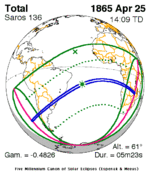 April 25, 1865 |  May 6, 1883 |  May 18, 1901 |
| 32 | 33 | 34 |
 May 29, 1919 |  June 8, 1937 |  June 20, 1955 |
| 35 | 36 | 37 |
 June 30, 1973 |  July 11, 1991 |  July 22, 2009 |
| 38 | 39 | 40 |
 August 2, 2027 |  August 12, 2045 |  August 24, 2063 |
| 41 | 42 | 43 |
 September 3, 2081 |  September 14, 2099 |  September 26, 2117 |
| 44 | 45 | 46 |
 October 7, 2135 |  October 17, 2153 | 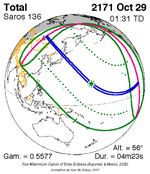 October 29, 2171 |
| 47 | ||
 November 8, 2189 | ||
Metonic series
The metonic series repeats eclipses every 19 years (6939.69 days), lasting about 5 cycles. Eclipses occur in nearly the same calendar date. In addition, the octon subseries repeats 1/5 of that or every 3.8 years (1387.94 days). All eclipses in this table occur at the Moon's descending node.
| 21 eclipse events between May 21, 1993 and May 20, 2069 | ||||
|---|---|---|---|---|
| May 20–21 | March 9 | December 25–26 | October 13–14 | August 1–2 |
| 118 | 120 | 122 | 124 | 126 |
 May 21, 1993 |  March 9, 1997 |  December 25, 2000 |  October 14, 2004 |  August 1, 2008 |
| 128 | 130 | 132 | 134 | 136 |
 May 20, 2012 |  March 9, 2016 |  December 26, 2019 |  October 14, 2023 |  August 2, 2027 |
| 138 | 140 | 142 | 144 | 146 |
 May 21, 2031 |  March 9, 2035 |  December 26, 2038 |  October 14, 2042 |  August 2, 2046 |
| 148 | 150 | 152 | 154 | 156 |
 May 20, 2050 |  March 9, 2054 |  December 26, 2057 |  October 13, 2061 |  August 2, 2065 |
| 158 | ||||
 May 20, 2069 | ||||
Tritos series
This eclipse is a part of a tritos cycle, repeating at alternating nodes every 135 synodic months (≈ 3986.63 days, or 11 years minus 1 month). Their appearance and longitude are irregular due to a lack of synchronization with the anomalistic month (period of perigee), but groupings of 3 tritos cycles (≈ 33 years minus 3 months) come close (≈ 434.044 anomalistic months), so eclipses are similar in these groupings.
| Series members between 1801 and 2200 | ||||
|---|---|---|---|---|
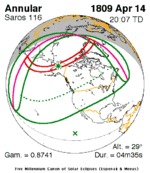 April 14, 1809 (Saros 116) |  March 14, 1820 (Saros 117) |  February 12, 1831 (Saros 118) | 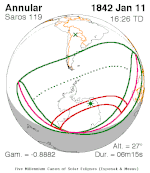 January 11, 1842 (Saros 119) |  December 11, 1852 (Saros 120) |
 November 11, 1863 (Saros 121) |  October 10, 1874 (Saros 122) |  September 8, 1885 (Saros 123) |  August 9, 1896 (Saros 124) |  July 10, 1907 (Saros 125) |
 June 8, 1918 (Saros 126) |  May 9, 1929 (Saros 127) |  April 7, 1940 (Saros 128) |  March 7, 1951 (Saros 129) |  February 5, 1962 (Saros 130) |
 January 4, 1973 (Saros 131) |  December 4, 1983 (Saros 132) |  November 3, 1994 (Saros 133) |  October 3, 2005 (Saros 134) |  September 1, 2016 (Saros 135) |
 August 2, 2027 (Saros 136) |  July 2, 2038 (Saros 137) |  May 31, 2049 (Saros 138) |  April 30, 2060 (Saros 139) |  March 31, 2071 (Saros 140) |
 February 27, 2082 (Saros 141) |  January 27, 2093 (Saros 142) |  December 29, 2103 (Saros 143) |  November 27, 2114 (Saros 144) |  October 26, 2125 (Saros 145) |
 September 26, 2136 (Saros 146) |  August 26, 2147 (Saros 147) | 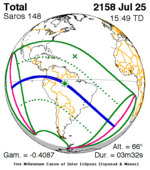 July 25, 2158 (Saros 148) |  June 25, 2169 (Saros 149) |  May 24, 2180 (Saros 150) |
 April 23, 2191 (Saros 151) | ||||
Inex series
This eclipse is a part of the long period inex cycle, repeating at alternating nodes, every 358 synodic months (≈ 10,571.95 days, or 29 years minus 20 days). Their appearance and longitude are irregular due to a lack of synchronization with the anomalistic month (period of perigee). However, groupings of 3 inex cycles (≈ 87 years minus 2 months) comes close (≈ 1,151.02 anomalistic months), so eclipses are similar in these groupings.
| Series members between 1801 and 2200 | ||
|---|---|---|
 December 20, 1824 (Saros 129) |  November 30, 1853 (Saros 130) |  November 10, 1882 (Saros 131) |
 October 22, 1911 (Saros 132) |  October 1, 1940 (Saros 133) |  September 11, 1969 (Saros 134) |
 August 22, 1998 (Saros 135) |  August 2, 2027 (Saros 136) |  July 12, 2056 (Saros 137) |
 June 22, 2085 (Saros 138) |  June 3, 2114 (Saros 139) | 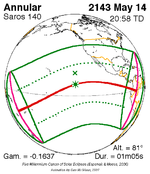 May 14, 2143 (Saros 140) |
 April 23, 2172 (Saros 141) | ||
References
- ^ "August 2, 2027 Total Solar Eclipse". timeanddate. Retrieved 13 August 2024.
- ^ "Moon Distances for London, United Kingdom, England". timeanddate. Retrieved 13 August 2024.
- ^ a b "Total Solar Eclipse on August 2, 2027: Path Map and Times". www.timeanddate.com. Retrieved 2024-03-23.
- ^ "Longest Duration of Total Solar Eclipse of 2027 Aug 02". NASA Goddard Space Flight Center. NASA. Retrieved 7 September 2017.
- ^ "Map of Solar Eclipse of August 2, 2027" (Map). "Solar Eclipse Maps". NASA. Retrieved October 21, 2017.
- ^ https://eclipse-spain.es/index.php/en/ [bare URL]
- ^ Fred Espenak. "Total Solar Eclipse of 2009 Jul 22 - Google Maps and Solar Eclipse Paths". NASA Eclipse Web Site. Archived from the original on 22 July 2009.
- ^ Fred Espenak. "Total Solar Eclipses with Durations Exceeding 06m 00s: 2001 to 3000". NASA Eclipse Web Site. Archived from the original on 10 March 2014.
- ^ "Total Solar Eclipse of 2027 Aug 02". EclipseWise.com. Retrieved 13 August 2024.
- ^ van Gent, R.H. "Solar- and Lunar-Eclipse Predictions from Antiquity to the Present". A Catalogue of Eclipse Cycles. Utrecht University. Retrieved 6 October 2018.
- ^ "NASA - Catalog of Solar Eclipses of Saros 136". eclipse.gsfc.nasa.gov.

External links
- NASA eclipse plot
- v
- t
- e
| By era | |
|---|---|
| Saros series (list) | |
| Visibility | |
| Historical |
|

Total/hybrid eclipses
→ next total/hybrid
- 1133
- 1185
- 1560
- 1598
- 1652
- 1654
- 1673
- 1706
- 1715
- 1724
- 1766
- 1778
- 1780
- 1806
- 1816
- 1824
- 1842
- 1851
- 1853
- 1857
- 1858
- 1860
- 1865
- 1867
- 1868
- 1869
- 1870
- 1871
- 1874
- 1875
- 1878
- 1882
- 1883
- 1885
- 1886
- 1887
- Jan. 1889
- Dec. 1889
- 1893
- 1896
- 1898
- 1900
- 1901
- 1903
- 1904
- 1905
- 1907
- Jan. 1908
- Dec. 1908
- 1909
- 1910
- 1911
- Apr. 1912
- Oct. 1912
- 1914
- 1916
- 1918
- 1919
- 1921
- 1922
- 1923
- 1925
- 1926
- 1927
- 1928
- 1929
- Apr. 1930
- Oct. 1930
- 1932
- 1934
- 1936
- 1937
- 1938
- 1939
- 1940
- 1941
- 1943
- Jan. 1944
- 1945
- 1947
- 1948
- 1950
- 1952
- 1954
- 1955
- 1956
- 1957
- 1958
- 1959
- 1961
- 1962
- 1963
- 1965
- 1966
- 1967
- 1968
- 1970
- 1972
- 1973
- 1974
- 1976
- 1977
- 1979
- 1980
- 1981
- 1983
- 1984
- 1985
- 1986
- 1987
- 1988
- 1990
- 1991
- 1992
- 1994
- 1995
- 1997
- 1998
- 1999
- 2001
- 2002
- 2003
- 2005
- 2006
- 2008
- 2009
- 2010
- 2012
- 2013
- 2015
- 2016
- 2017
- 2019
- 2020
- 2021
- 2023
- 2024
- → 2026
- 2027
- 2028
- 2030
- 2031
- 2033
- 2034
- 2035
- 2037
- 2038
- 2039
- 2041
- 2042
- 2043
- 2044
- 2045
- 2046
- 2048
- 2049
- 2050
- 2052
- 2053
- 2055
- Jan. 2057
- Dec. 2057
- 2059
- 2060
- 2061
- 2063
- 2064
- 2066
- 2067
- 2068
- 2070
- 2071
- 2072
- 2073
- 2075
- 2076
- 2077
- 2078
- 2079
- 2081
- 2082
- 2084
- 2086
- 2088
- 2089
- 2090
- 2091
- 2093
- 2094
- 2095
- 2096
- 2097
- 2099
- 2100
- 2186

Annular eclipses
→ next annular
- 1820
- 1854
- 1879
- 1889
- 1900
- 1901
- 1903
- 1904
- 1905
- 1907
- 1908
- 1911
- 1914
- Feb. 1915
- Aug. 1915
- 1916
- 1917
- 1918
- 1919
- 1921
- 1922
- 1923
- 1925
- 1926
- 1927
- 1929
- 1932
- Feb. 1933
- Aug. 1933
- 1934
- 1935
- 1936
- 1937
- 1939
- 1940
- 1941
- 1943
- Jul. 1944
- 1945
- 1947
- 1948
- 1950
- Mar. 1951
- Sep. 1951
- 1952
- Jan. 1954
- Dec. 1954
- 1955
- 1957
- 1958
- 1959
- 1961
- 1962
- 1963
- 1965
- 1966
- Mar. 1969
- Sep. 1969
- 1970
- 1972
- Jan. 1973
- Dec. 1973
- 1976
- 1977
- 1979
- 1980
- 1981
- 1983
- 1984
- 1987
- 1988
- 1990
- 1991
- 1992
- 1994
- 1995
- 1998
- 1999
- 2001
- 2002
- 2003
- 2005
- 2006
- 2008
- 2009
- 2010
- 2012
- 2013
- 2014
- 2016
- 2017
- 2019
- 2020
- 2021
- 2023
- → 2024
- 2026
- 2027
- 2028
- 2030
- 2031
- 2032
- 2034
- 2035
- 2036
- Jan. 2038
- Jul. 2038
- 2039
- 2041
- 2042
- 2043
- 2044
- 2045
- 2046
- 2048
- 2049
- 2052
- 2053
- Jan. 2056
- Jul. 2056
- 2057
- 2059
- 2060
- 2061
- 2063
- 2064
- 2066
- 2067
- 2070
- 2071
- Jan. 2074
- Jul. 2074
- 2075
- 2077
- 2078
- 2079
- 2081
- 2082
- 2084
- Jun. 2085
- Dec. 2085
- 2088
- 2089
- Feb. 2092
- Aug. 2092
- 2093
- 2095
- 2096
- 2097
- 2099
- 2100

Partial eclipses
→ next partial
- Jan. 1639
- Apr. 1902
- May 1902
- Oct. 1902
- Feb. 1906
- Jul. 1906
- Aug. 1906
- Dec. 1909
- Nov. 1910
- Apr. 1913
- Aug. 1913
- Sep. 1913
- Dec. 1916
- Jan. 1917
- Jun. 1917
- Jul. 1917
- May 1920
- Nov. 1920
- Mar. 1924
- Jul. 1924
- Aug. 1924
- Dec. 1927
- Jun. 1928
- Nov. 1928
- Apr. 1931
- Sep. 1931
- Oct. 1931
- Jan. 1935
- Feb. 1935
- Jun. 1935
- Jul. 1935
- Nov. 1938
- Mar. 1942
- Aug. 1942
- Sep. 1942
- Jan. 1946
- May 1946
- Jun. 1946
- Nov. 1946
- Apr. 1949
- Oct. 1949
- Feb. 1953
- Jul. 1953
- Aug. 1953
- Dec. 1956
- Mar. 1960
- Sep. 1960
- Jan. 1964
- Jun. 1964
- Jul. 1964
- Dec. 1964
- May 1967
- Mar. 1968
- Feb. 1971
- Jul. 1971
- Aug. 1971
- Dec. 1974
- May 1975
- Nov. 1975
- Apr. 1978
- Oct. 1978
- Jan. 1982
- Jun. 1982
- Jul. 1982
- Dec. 1982
- May 1985
- Apr. 1986
- Mar. 1989
- Aug. 1989
- Dec. 1992
- May 1993
- Nov. 1993
- Apr. 1996
- Oct. 1996
- Sep. 1997
- Feb. 2000
- 1 Jul. 2000
- 31 Jul. 2000
- Dec. 2000
- Apr. 2004
- Oct. 2004
- Mar. 2007
- Sep. 2007
- Jan. 2011
- Jun. 2011
- Jul. 2011
- Nov. 2011
- Oct. 2014
- Sep. 2015
- Feb. 2018
- Jul. 2018
- Aug. 2018
- Jan. 2019
- Apr. 2022
- Oct. 2022
- → Mar. 2025
- Sep. 2025
- Jan. 2029
- Jun. 2029
- Jul. 2029
- Dec. 2029
- 2032
- 2033
- Feb. 2036
- Jul. 2036
- Aug. 2036
- 2037
- May 2040
- Nov. 2040
- Jan. 2047
- Jun. 2047
- Jul. 2047
- Dec. 2047
- 2050
- Apr. 2051
- Oct. 2051
- Mar. 2054
- Aug. 2054
- Sep. 2054
- 2055
- May 2058
- Jun. 2058
- Nov. 2058
- Mar. 2062
- Sep. 2062
- Feb. 2065
- Jul. 2065
- Aug. 2065
- Dec. 2065
- 2068
- Apr. 2069
- May 2069
- Oct. 2069
- 2072
- 2073
- Jun. 2076
- Jul. 2076
- Nov. 2076
- Feb. 2083
- Jul. 2083
- Aug. 2083
- 2084
- 2086
- May 2087
- Jun. 2087
- Oct. 2087
- 2090
- 2091
- Jun. 2094
- Jul. 2094
- Dec. 2094
- Apr. 2098
- Sep. 2098
- Oct. 2098
 Astronomy portal
Astronomy portal Solar System portal
Solar System portal Category
Category














